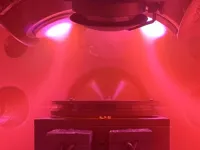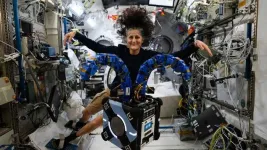(Press-News.org) FOR IMMEDIATE RELEASE
Media Contact: Levi.Gadye@ucsf.edu, (415) 502-6397
Subscribe to UCSF News
The discovery of a new type of stem cell in the brain could usher in better treatments for the deadliest brain tumor.
UCSF scientists have discovered a stem cell in the young brain that’s capable of forming the cells found in tumors. The breakthrough could explain how adult brain cells take advantage of developmental processes to instigate the explosive growth seen in deadly brain cancers like glioblastoma.
They made the discovery while taking a broad genomic survey of human brain cells from the first two decades of life. The findings appear Jan. 8 in Nature.
“Many brain diseases begin during different stages of development, but until now we haven’t had a comprehensive roadmap for simply understanding healthy brain development,” said Arnold Kriegstein, MD, PhD, professor of neurology at UCSF and co-corresponding author of the paper. “Our map highlights the genetic programs behind the growth of the human brain that go awry during specific forms of brain dysfunction.”
The study measured gene expression in cells taken from donated brain samples. The researchers kept track of the original location of each cell to help explain how the brain creates connections.
In addition to the discovery of an early stem cell that could explain the genetics of glioblastoma in adulthood, the data contained hints about the origins of autism. The researchers have published the data as a resource for the field to use for understanding a wide range of other brain disorders.
“Our study paints one of the most detailed pictures of human brain development,” said Li Wang, PhD, postdoctoral researcher in Kriegstein’s laboratory and co-first and co-corresponding author of the paper. “Theories based on observations in the clinic and laboratory can now be tested against this hard data, and we’re excited to see what else the field can do with it.”
Samples reveal a treasure trove
Most studies of the developing brain are carried out in animal models, which are at best loose proxies for the human brain.
The team, also led by co-first author Cheng Wang, PhD, and co-corresponding author Jingjing Li, PhD, wagered that valuable new insights could be made by studying the human brain itself. They worked with the National Institutes of Health’s NeuroBioBank and local hospitals associated with UCSF to obtain brain samples.
These samples, donated from 27 individuals from early life through adolescence, were sent to UCSF and analyzed for gene expression in thousands of individual cells.
Gene expression refers to how DNA, stored in chromosomes, is copied into RNA – short-lived genetic messages – which are then used as a template for building proteins. By measuring RNA, the researchers could peer into the behavior of those cells.
“RNA degrades quickly, and you need to have very pristine tissue in order to get usable data,” Kriegstein said. “It was a huge advance for Li and his colleagues to perform such high-resolution genomic tests on this tissue, and we thank the community for supporting such critical research by donating this precious tissue.”
The researchers analyzed which parts of each chromosome were available for expressing genes in each cell. They also labeled where each cell had been taken from in the brain.
The scientists focused on cells taken from the front and the back of the cerebral cortex, regions that in humans are responsible for learning, memory and language.
“RNA alone doesn’t tell the entire story of a cell’s behavior,” Wang said. “By measuring RNA and chromatin state at the same time in the same cell and then mapping each cell back into the brain’s structure, we could begin to understand the full story of brain development.”
A mélange of autism risk genes emerge in the developing brain
Autism isn’t caused by a single gene mutation, but rather by the combination of many gene mutations.
The researchers found that many of the genes that correlate with autism were turned on by immature neurons well before any symptoms would have manifested. Mutations in these genes, they said, could interfere with the growth of the young brain, leading to autism.
“These programs of gene expression became active when young neurons were still migrating throughout the growing brain and figuring out how to build connections with other neurons,” Wang said. “If something goes wrong at this stage, those maturing neurons might become confused about where to go or what to do.”
Since the study didn’t look at tissue from individuals with autism, it’s still unclear exactly how autism unfolds in the brain. But the data link many genetic variations associated with autism to the cells that serve as the building blocks for the growing brain.
“People talk about connecting the dots to come up with a picture of how autism emerges, and in a sense, we've identified many of the dots driving autism during a critical point in development,” Kriegstein said. “This part of development could be worthy of further investigation for untangling all the mysteries of autism.”
Could a program for early brain growth be coopted for tumor growth later in life?
As the researchers sifted through their data, Wang noticed a group of stem cells that seemed poised to do something unusual. These immature cells had begun to express genes normally found across three mature cell types.
Many stem cells in the developing brain mature into just one cell type, like a neuron or a support cell. Some can mature into two types. But these stem cells could mature into three lineages: two types of support cells known as glia, and one type of neuron.
The researchers thought this ability might enable it to give rise later in life to glioblastoma tumors, which contain three similar cell types.
“Glioblastoma has been challenging because it's so heterogeneous,” Kriegstein said. “Li found a precursor capable of making all three glioblastoma cell types.”
The discovery validates a widely held theory that tumors hijack genetic growth programs for out-of-control growth in adulthood.
And it may provide a new entree for treating glioblastoma at its source: the “cancer stem cell.”
“By understanding the context in which one stem cell produces three cell types in the developing brain, we could be able to interrupt that growth when it reappears during cancer,” Wang said.
Authors In addition to Wang, Wang, Li, and Kriegstein, other UCSF authors are Juan A. Moriano, PhD, Songcang Chen, MD, Guolong Zuo, PhD, Arantxa Cebrián-Silla, PhD, Shaobo Zhang, MD, Tanzila Mukhtar, PhD, Shaohui Wang, Mengyi Song, PhD, Lilian Gomes de Oliveira, MA, Qiuli Bi, Jonathan J. Augustin, PhD, Xinxin Ge, PhD, Mercedes F. Paredes, MD, PhD, Eric J. Huang, MD, PhD, Arturo Alvarez-Buylla, PhD, and Xin Duan, PhD.
Funding and disclosures: The work was supported in part by grants from the NIH (U01MH114825, R35NS097305, P01NS083513, R01NS123912, K99MH131832). Kriegstein is a co-founder, consultant and director of Neurona Therapeutics. For all other funding, see the paper.
About UCSF: The University of California, San Francisco (UCSF) is exclusively focused on the health sciences and is dedicated to promoting health worldwide through advanced biomedical research, graduate-level education in the life sciences and health professions, and excellence in patient care. UCSF Health, which serves as UCSF's primary academic medical center, includes top-ranked specialty hospitals and other clinical programs, and has affiliations throughout the Bay Area. UCSF School of Medicine also has a regional campus in Fresno. Learn more at ucsf.edu, or see our Fact Sheet.
###
Follow UCSF
ucsf.edu | Facebook.com/ucsf | YouTube.com/ucsf
END
The genes that grow a healthy brain could fuel adult glioblastoma
2025-01-08
ELSE PRESS RELEASES FROM THIS DATE:
New MSU study explains the delayed rise of plants, animals on land
2025-01-08
EAST LANSING, Mich. – If you like the smell of spring roses, the sounds of summer birdsong and the colors of fall foliage, you have the stabilization of the ozone layer to thank for it. Located in the stratosphere where it shields the Earth from harmful ultraviolet radiation, the ozone layer plays a key role in preserving the planet’s biodiversity.
Now, we may have a better idea of why that took more than 2 billion years to happen.
Michigan State University researcher Dalton Hardisty contributed to a new Yale University-led study finding that Earth’s early atmosphere hosted a battle royal between ...
UTA becomes one of largest natural history libraries
2025-01-08
Thanks to in-kind donations of tens of thousands of rare books, scientific journals, and articles, and reports over the past two years, The University of Texas at Arlington’s Amphibian and Reptile Diversity Research Center (ARDRC) has become one of the largest publicly accessible herpetology libraries in the world.
“Thanks to 12 independent donors, including the Joseph Rex Dinardo Jr. Herpetology and Natural History Science Research Trust in Philadelphia, Dr. Jonathan Campbell, William Lamar, Drs. Jay and Rebecca Savage, and Louis Porras, we now have thousands ...
Number of autistic individuals enrolled in Medicaid and receiving federal housing support increased by 70% from 2008-16
2025-01-08
Affordable and stable housing is critical to improving health across a person's lifespan. People with disabilities, including autism, comprise a significant share of people in need of housing assistance. However, the intersection of housing and health among individuals with autism is largely unknown because data on public housing and public health are not connected. Researchers from Drexel University’s A.J. Drexel Autism Institute examined how many autistic people in the United States received housing ...
St. Jude scientists create scalable solution for analyzing single-cell data
2025-01-08
Researchers have amassed vast single-cell gene expression databases to understand how the smallest details impact human biology. However, current analysis methods struggle with the large volume of data and, as a result, produce biased and contradictory findings. Scientists at St. Jude Children’s Research Hospital created a machine-learning algorithm capable of scaling with these single-cell data repositories to deliver more accurate results. The new method was published today in Cell Genomics.
Before single-cell analysis, bulk gene expression data ...
What is the average wait time to see a neurologist?
2025-01-08
MINNEAPOLIS – Older people wait an average of just over a month to see a neurologist for specialty care after being referred by their primary care physician or another physician, according to a study published in the January 8, 2025, online issue of Neurology®, the medical journal of the American Academy of Neurology. The study, which looked at people who have Medicare insurance, also found some people wait more than three months to see a neurologist.
“Neurologists provide important and ongoing care for people ...
Proximity effect: Method allows advanced materials to gain new property
2025-01-08
UNIVERSITY PARK, Pa. — Ferroelectrics are special materials with polarized positive and negative charges — like a magnet has north and south poles — that can be reversed when external electricity is applied. The materials will remain in these reversed states until more power is applied, making them useful for data storage and wireless communication applications.
Now, turning a non-ferroelectric material into one may be possible simply by stacking it with another ferroelectric material, according to a team led by scientists from Penn State who demonstrated the phenomenon, called proximity ferroelectricity.
The ...
LJI researchers shed light on devastating blood diseases
2025-01-08
LA JOLLA, CA—Scientists at La Jolla Institute for Immunology (LJI) have discovered how a mutated gene kicks off a dangerous chain of events during blood cell production.
The study, published recently in the Proceedings of the National Academy of Sciences, reveals how a mutated gene called ASXL1 is involved in a disease called clonal hematopoiesis, a precursor to malignant diseases such as myeloid malignancies and chronic monomyelocytic leukemia.
"We know that many diseases—and all cancers—are driven by mutations in the genome," says LJI Instructor Zhen Dong, ...
ISS National Lab announces up to $650,000 in funding for technology advancement in low Earth orbit
2025-01-08
KENNEDY SPACE CENTER (FL), January 7, 2025 – The International Space Station (ISSInternational Space Station) National Laboratory is soliciting flight concepts for technology advancement that utilizes the space-based environment of the orbiting laboratory. This solicitation, “Technology Advancement and Applied Research Leveraging the ISS National Lab,” is open to a broad range of technology areas, including chemical and material synthesis in space, translational medicine, in-space edge computing, and in-space servicing, assembly, and manufacturing. It also encompasses the application of space station remote sensing data to improve geospatial analytics ...
Scientists show how sleep deprived brain permits intrusive thoughts
2025-01-08
A new study has shown that sleep deprivation can inhibit the brain’s ability to suppress unwanted memories and intrusive thoughts.
Scientists at the University of York, in collaboration with the University of East Anglia, have shown that sleep deprivation interferes with the ability of the prefrontal area of the brain to restrict the retrieval of memories that would have otherwise been suppressed.
Dr Scott Cairney from the University of York said: “Memories of unpleasant experiences often intrude into our conscious ...
UC Irvine-led team discovers potential new therapeutic targets for Huntington’s disease
2025-01-08
Irvine, Calif., Jan. 8, 2025 — A University of California, Irvine-led research team has discovered intricate molecular mechanisms driving the RNA processing defects that lead to Huntington’s disease and link HD with other neurodegenerative disorders such as amyotrophic lateral sclerosis, frontotemporal lobar dementia and Alzheimer’s disease.
The findings may pave the way for neurodegenerative disorder researchers to collaborate and share therapeutic strategies across diseases, opening additional avenues for treatment.
While it’s known that HD is caused by an abnormal ...



